Mario and Luigi: Superstar Saga - Pure, Hilarious, Adventure
19/10/23
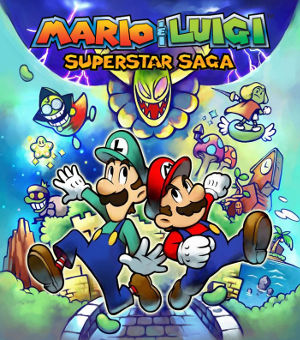
There are a number of games that I feel are mini markers in my life. At the tender age of two, I watched my uncle and cousin play Diddy Kong Racing for the N64, igniting my love of gaming. Super Mario 64 was the first game I ever owned, and Jak and Daxter: The Precursor Legacy blew my mind open to the medium’s potential.I don’t quite know how Mario and Luigi: Superstar Saga fits into this; perhaps it showed me the potential of handheld gaming. Maybe it solidified my love for Mario and Luigi as a duo. Either way, this game is very near and dear to my heart. So, for the very special, fiftieth review for the Game Boy Abyss, we’ll be taking a look at one of the very best games to grace this handheld - Mario & Luigi: Superstar Saga.
I hope you won’t mind this review prattling on more than a little bit; it’s my fiftieth review, and Superstar Saga ranks amongst the games dearest to me, not only on the Game Boy Advance, but in games in general.
Superstar Saga is probably where my love affair with the Game Boy Advance began. As a kid, when I only had access to physical games, it was by far the one I loved the most. To be fair, I didn’t actually own it - my best friend at the time did, but it was one of those situations where we kind of had joint custody of the game, working together to make our way through it. Coming out in the mid-life of the Game Boy Advance, Mario and Luigi: Superstar Saga wasn’t the first, or even the second, RPG series featuring Nintendo’s golden boy. Following up on the fantastic Super Mario RPG: Legend of the Seven Stars and Paper Mario, Superstar Saga is a wackier, more action-RPG oriented take on the genre. Pairing down the full RPG party to just the two Mario Brothers, Superstar Saga puts it’s focus squarely on it’s humour, it’s insanity, and it’s more interactive combat as opposed to its predecessors, whilst at the same time maintaining a rock-solid idea of what Mario is, and expanding his world in a more natural, somehow believable way.
Chiefly, the reason I still look so fondly back on Mario and Luigi: Superstar Saga is because this plucky title features one of the genuinely best RPG battle systems of all time - certainly *of* the time. Its timing and reaction based battle system is something I’ve adored for decades, and whilst I wouldn’t say it ‘ruined’ other RPGs for me, the way it keeps the game constantly interactive can turn other RPGs into a bit of a snoozefest. It’s a surprisingly simple system - you control Mario and Luigi exclusively with the A and B button, respectively. Basic moves are what you expect; Jumps, Hammer Attacks, and a special elemental-based move you’ll get around halfway into the game. Each attack can be used and that’s that, you’ll deal damage, but timing a second button press at a certain moment in the animation - tapping B just as Luigi is about to land on an enemy’s head, for an example - will deal additional damage. Additionally, certain foes are immune to certain attacks - you can’t just jump on a foe with a spiked helmet, that hurts! It’s a simple addition that I really like, not only because it encourages you to switch your tactics, but standing on spikes *really does* hurt. I dunno, it makes me laugh.
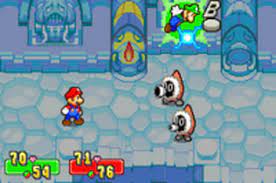
Beyond their basic attacks, Mario and Luigi can also employ Bros. Attacks that require both brothers to be available. Costing Bros. points - M&L’s equivalent to MP - Bros. Attacks are combination attacks that’ll require you to time a certain combination of inputs to deal massive damage. Rather then throwing you in the deep end, Superstar Saga gives each Bros. move ‘levels’ - at level 1, the game will slow down and show your button prompt when it’s needed, whilst at level 3, the move runs at normal speed and only a coloured splash will appear to indicate the input, with the upside of higher damage. They’re exciting, more than a bit silly and incredibly satisfying to master. As a twenty-seven year old, I can just throw on Level 3 and go on, but I *know* eight-year old me clung to Level 1 and 2 for a long, long time, and I just really appreciate how the game caters to the best of both worlds.
But easily the crowning jewel of this combat system is the dodge-and-counter system In most turn-based RPGs, you’ll just be getting slapped by foes until it’s your turn, but Superstar Saga keeps the ball in your court, in a sense. Say a Goomba is coming to ram you; rather than taking the hit, you’ll have the chance to jump and avoid the hit, or if you time it just right, jump on *their* head and counterattack. This is the simplest version of this system, but the vast majority of enemies have some sort of move or behavior that’ll keep you on your toes and stop you from falling into patterns. Boss fights take this to the extreme, capable of doing a lot of am This isn’t an opt-in system, by the way. If you don’t dodge and counterattack, you will get taken down, especially in the game’s more lengthy boss encounters, but I can’t imagine anyone disliking the dodge-and-counter element of the game, it’s permanently skewed how I see general RPG combat - and thankfully, each successive game in the series has done the battle system better and better.
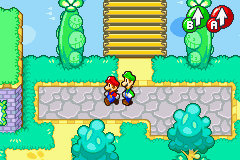
Mario and Luigi: Superstar Saga is pretty much a world tour of the BeanBean Kingdom. You’ll be moving from zone to zone at a relatively linear pace as the plot allows, though a decent chunk of optional secrets and sidequests open up as you learn new abilities and gain new tools that open up the world. But for the most part, each area follows the same little pattern - head to the area, navigate a dungeon-like environment, solve some puzzles and fight a boss. It is a bit formulaic, especially in the front half of the game, but it never really bothered me. With the decent variety of puzzles, enemy patterns and locales, it barely feels like you’re treading the same formula for much of the game. The puzzles are probably the weakest link of the game; they’re not really bad, but they feel a bit middling at times and they’re generally quite easy, but I’d expect a kid to resonate with them a decent bit more. There are a few minigames dotted about the world, usually requiring a play to progress, but can be completed further times to earn Beans that’ll feed into one of the game’s major side quests, Starbean Coffee, where you can trade the myriad of beans you’ll uncover across the world to earn unique items and stat boosts from one of Luigi’s most classic allies. The minigames themselves are alright, a little on the basic side, but I really enjoy the Barrel slider minigame in the Ghost Ship, along with the tilt-and-tumble arcade machine up in Little Fungitown.
In its last act, the game eschews its formula and opens up the world, sending our brothers off on a treasure hunt to the corners of the BeanBean kingdom in a relatively non-linear fashion. For a lot of games that pull this kind of stunt, a’la the Triforce hunt in The Wind Waker, it frequently just feels like a cheap tactic to stretch out the game just that little bit more, but in the case of Superstar Saga, this is anything but. Sure, you’ll be visiting all the locales you’ve explored before, but they’re always just nice little extensions of the stories and aesthetics of those locations, and Superstar Saga’s areas are just so beautiful and fun to run around in that I really didn’t mind returning to previously treated ground. And, to be fair, I could probably run around a decent chunk of the BeanBean Kingdom - especially the early game - with my eyes closed. I spent far, far too much time in the early game, and not for the reasons you’d think.
I remember when I first played this; I borrowed it from one of my friends, and this was back in 2003-2004, when neither of us had any concept of the idea of video game walkthroughs, and being seven year olds, were really, really stupid. Anyway, upon reaching Chucklehuck Woods, we both hit a wall. It wasn’t any kind of enemy, or particularly hard platforming section. No, you see, once you learn the ability to pancake Luigi into the ground, you’re required to navigate him under a barrel, which you can then move to deflect a projectile. Well, for some reason, neither of us worked out you could actually perform such a basic feat. We spent *months* trying to work this out, which included convincing ourselves we needed to level Mario and Luigi’s Stache stat up to 30 - I’ve been wracking my brain, and I just can’t remember why the hell we thought that was the solution. I don’t even remember *how* we struggled with this - there’s a bloody sign basically telling you to do that! It’s a bit embarrassing, but I was very young, and it probably is one of the things that’s endeared me to the Superstar Saga to me over the years.
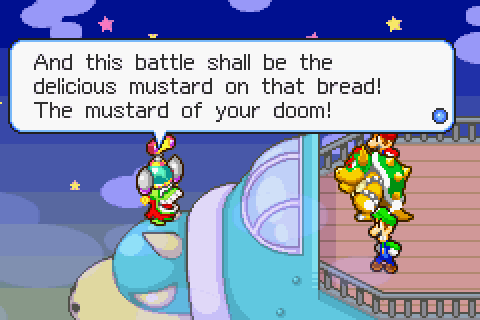
It wouldn’t surprise me if Superstar Saga was a bit formative in regards to how I see comedy. To put it lightly, this game is hysterical. The jokes might not pile down at a machine gun pace, but moments where this game isn’t doing *something* hilarious is rare. The depiction of Mario and Luigi having to convey everything, at least to us, in slapstick, broken italian, as they swing their arms back and forth is quite possibly the funniest thing Nintendo have ever done. The sheer amount of puns, lowkey humour, and whatever the hell kind of dialogue Fawful is spouting is nothing short of brilliant. Even tiny details - like Luigi’s sprite sitting off to the side, lightly poking something out of boredom, or the way the brothers panic as a boss fight emerges kill me every time. Also, the sheer brutality in which Luigi is bullied, both physically and emotionally, unfortunately for him never stops being funny. Any single instance of Luigi being referred to as ‘Mr Green Stache’ or ‘Green Mario’ consistently had me in stitches.
The story itself is pretty much an afterthought, but it’s perfect for what it is - reasons for our Superstar duo to get into increasingly more bizarre and wacky adventures to poke fun at, and just provide vehicles for newer, weirder characters for them to bounce off. Rather than being kidnapped, this time, Peach’s voice has been stolen by the witch Cackletta for unknown reasons, forcing Mario and a reluctant Luigi to travel internationally to the Beanbean Kingdom to retrieve it, with all the wacky hijinks you’d expect. This is the Mario universe at its very best and it’s very weirdest. Think about it, outside the Mario and Luigi series, and its sister RPG franchises, we rarely have characters like Fawful, like Popple, or even minor characters like the Hoo and Hammerhead Bros. Even Prince Peasley, who looks like he belongs in some kind of vegetable themed shoujo manga, never fails to make me giggle at his stupendously over-the-top dialogue. Cackletta is a great villain, beginning the M&L tradition of foes who, whilst funny and fitting the Mario fold, can become genuinely intimidating, even frightening foes in their most desperate moments. Seriously, Cackletta’s stretched and threatening sprite is really something. I really love how, as was common with the RPG side-series, Superstar Saga expanded Mario’s world in a natural way. It’s never a real focus, but the minor political undertones of the story, the relationship between the BeanBean and Mushroom Kingdoms - hell, even the fact that Little Fungitown exists and has an embassy is just a really cool touch that makes the world feel… grounded, in a way that makes sense for Mario.
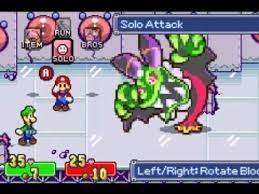
And to depict that expanded world and its crazed denizens, we have some of the most beautiful sprite work on the console. I love, love, LOVE how Superstar Saga looks, with each of its zones featuring distinct, varied environments that’ll stick in your mind. The lonely, eerie Stardust Fields, the familiar tones of BeanBean Castle Sewers, or the cozy - yet dangerous - vibes of TeeHee valley… Nothing would make me happier than for a 3D Mario in the vein of 64 or Odyssey to return to the BeanBean kingdom. It just perfectly straddles the line between absolute lunacy, and something that could just genuinely exist in Mario’s universe. At on that note, Superstar Saga feels like a massive tribute to what came before, with references to the original Donkey Kong, guest appearances from old friends like Toadsworth and Prof. E Gadd and even a cameo from Geno! My man, Geno! Additionally, the sheer design variety of the foes and bosses of the BeanBean Kingdom blew me away even nearly two decades on, feeling pretty unlike anything that had come from ‘traditional’ Mario games before.
I also can’t move on without shouting out the soundtrack to this game, composed by arguably the best composer currently working in the industry, Yoko Shimomura. Certain tracks, such as both major boss themes and the theme that plays in the damaged BeanBean Castle Town, have been burned into my mind for literally decades, and getting to listen to them all again has been nothing short of a treat. It’s not quite on the level of some of the work she did in the future - chiefly the later Mario and Luigi games, or her work with Kingdom Hearts - but it’s undoubtedly still one of the best and most memorable soundtracks present on the Game Boy Advance in general. Seriously, just throw on TeeHee Valley’s theme and just let your worries melt away.
It’s amazing how time changes so much. When I think back to my first, full playthrough of Superstar Saga, I just think of how *long* it took me. Chuckhuck Woods incident aside, I remember so many bosses kicking my ass - the creature at the top of HooHoo Mountain, Queen Bean, and *especially* the final boss. The game took me dozens of hours to complete, but upon my most recent run, I was aghast at how… easy, to a point, it was. Thinking it over, I’d say it probably lies with the game’s reaction-based battle system. Children are stupid, and it’s a lot harder to react to some of the stuff this game throws at you in its encounters. But now, after more than twenty years (and a handy amount of knowledge regarding the game), my general reaction speed is better and I’m just generally better at games. But still, it’s a little amusing - and a little melancholy, if I’m being honest - to see how different a game can feel across twenty years. When I was very small, this game was genuinely perfect in my eyes. I still love it so, so dearly, but it’s not ageless. I think I overuse this phrase sometimes, but you really can’t go home again, can’t you? Also, I think putting a ton of my stat bonuses into Stache after the Chucklehuck incident probably didn’t help with making the game any easier, all those years ago, either.
Writing this review has been hard. Superstar Saga has always been one of my very favorites on the GBA, and one of the most personal games I’ve ever played. I’m sure there are flaws baked into this game; it’s easy difficulty, for one, and occasionally unfulfilling side content, but it just doesn’t really matter to me. It’s a game that shaped my sense of comedy, defined a genre in my eyes, and features one of the most unique depictions of Mario and Luigi’s world… Well, ever. I adore this game to death, and if that makes me biased… Well, who cares. Mario and Luigi: Superstar Saga is one of the very best games on the Game Boy Advance, one that is basically required playing if anything in this review has appealed to you. Rest in peace, AlphaDream - you’ve done more for Mario, and for me, then you could ever know.
Thank you so, so much for reading my fiftieth review for The Game Boy Abyss. I know I’ve said it before, but I can’t believe I’ve made it this far. I was sure I’d grow bored of it, or completely burnt out, or any number of things. But knowing that people read these, and genuinely enjoy and play the games I recommend (and sometimes don’t!) makes it worthwhile. Thank you again for reading, truly, and thank you for sticking around for all this inane madness. Sorry for the extra long review! The next two games will be a double Halloween pairing; Game #51 will be a proper Halloween (in a sense) title, whilst Game #52 is a macabre title with relevance to a recent media release. As always, you can email me at mgeorge7003@hotmail.com or cckaiju@gmail.com if you have any questions or requests. Thank you again for reading, and I’ll see you in my next review.
